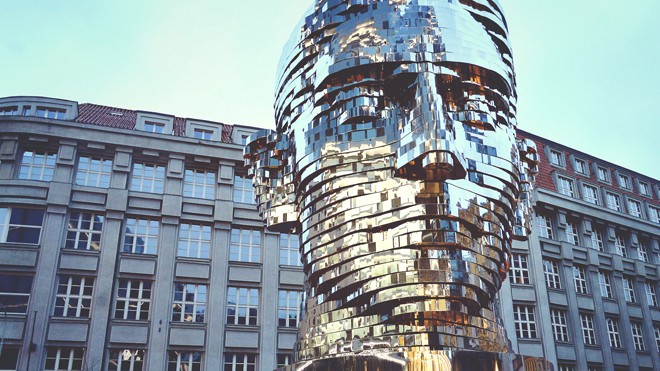
Prague, where Franz Kafka was born and lived, still has traces of the writer’s presence

There could be two reasons to pick Prague as your travel destination. One, you’re already on your Europe tour, you have heard about the place and you don’t want to miss it. Two, you know Kafka and -- well -- you don’t want to miss it.
Prague was once not only the capital of the Czech Republic but also the Holy Roman Empire. Today, it’s all Kafka-esque. Since Kafka was born here, lived here, and is buried here; you can see him all over the place. Being a German speaker and belonging to a Jewish family in a predominantly Czech area, he struggled all his life with a sense of alienation. Although he never really mentioned Prague in his writings, he was greatly influenced by it.
We know that Kafka was a tortured writer and this can be experienced while roaming the town.
Once standing at a window at the Oppelt House at Old Town Square, Kafka looked out and said, "this narrow circle encompasses my entire life," claims David Farley of The New York Times. Probably, the reason that most old places have been quite cleverly isolated from the new Prague.
Prague, in native language, is called Praha. The sweet sound of the word took the edge off me, and the unsettling feeling I encountered when I reached there. You can, and should, travel to Prague via train. But it is necessary for you to carry a printed copy of your ticket; otherwise the Czech police can fine you for not having a ticket at all. Even though the surrounding countries allow you to check in simply through your smart phone; Praha does not.
Cabs or taxis are rare, but there is a huge network of local transport across the city. Old trams and trolleys cover all city zones. The smaller the zone you are in, the more expensive your stay is; logically, Zone One is more touristy, and hence, more expensive. Estimates claim that over a couple of million tourists visit Prague each year; so you have to book your hotel, or a hostel or even a private quarter a few months ahead of your trip.
You can easily spend three to four days in Prague starting from a walk over the famous Charles Bridge. The bridge was built in the 15th century to replace the old Judith Bridge built around 1172. Almost 30 baroque-style sculptures were erected on the bridge from 1685 to 1715 depicting various saints and patron saints. The breathtaking scenic view of the Vltava River that it provides is what Prague cashes in on.
Other must visit places include Prague’s ninth century castle complex on top of the hill, Museum of Communism, Torture Museum, David Cerny’s Public Sculptures; but my most favourite would be the Old Town Square and Prague’s libraries.
The Klementinum library was opened in 1722 as part of the Jesuit University and has a majestic Baroque architecture. To match the attraction, Municipal Library of Prague built an awe-inspiring giant tower made of books. The sculpture consists of old books and mirrors creating an effect of infinity -- a path of knowledge. Another place that is not to be missed would be the 600-year old astronomical clock at the Old Town Square. Hundreds of tourists line up in front of the clock every hour to witness its procession of Apostles, moving statues, and visualisation of time through spiral rings, consistently tracking the motion of the sun and the moon. It’s absolutely magnificent!
Decades ago Kafka owned Praha; today Praha owns Kafka and that too commercially -- to the extent that it can get nauseating to see his face on coffee mugs, and apparels, and all kinds of souvenirs. Interestingly, most Czechs were not familiar with Kafka. His writings were banned during the German occupation, and then the anti-German sentiment followed by the Communist agenda kept him in the dark. It all changed after the Velvet Revolution; foreign tourists made the natives realise Kafka’s importance and today there are tributes splattered around the city.
"In Rome, the statues; in Paris, the paintings; and in Prague, the buildings suggest that pleasure can be an education," said Caleb Crain in his Necessary Errors. This rings true because you will find many buildings where Kafka once resided, though almost all of them have been modified now. In the Jewish quarters stands the city’s official monument showing Kafka sitting on the shoulders of a gigantic headless man.
The relatively new centre of the city has a 36-foot-high sculpture of Kafka’s head made out of 42 chrome-plated layers moving both in synchrony and opposite directions. The square has a couple of Indian restaurants around as well; or you should walk to Cafe Louvre, just a block away. The Cafe is known to be Kafka’s and Albert Einstein’s hang-out place. It has a rather narrow entrance but the grand staircase leads up to large billiards room.
The official currency in the Prague is the Czech Crown, though few hotels and restaurants also accept Euros but it could cost a bit more than the actual exchange rate. You’ll find money exchange outlets at almost every corner, but just make sure that you’re getting the Czech Crown and not some other currency.